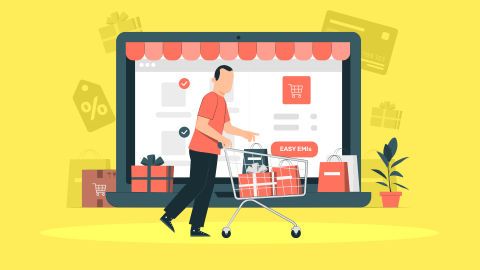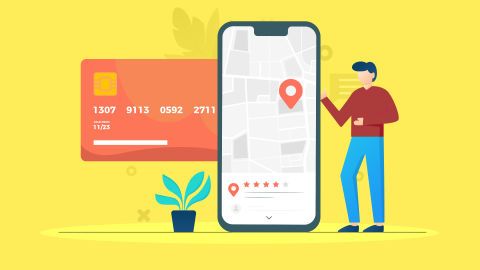Swiping a card at a store feels effortless, but have you ever wondered how the transaction is processed? The answer lies in POS systems. The POS full form is Point of Sale, the system that enables card payments in retail stores. It connects merchants, banks, and customers to ensure smooth transactions.
When you use a debit or credit card at checkout, the POS terminal authenticates the payment, deducts the amount, and confirms the purchase. This system is crucial for seamless transactions, whether for groceries, electronics, or apparel. With a Bajaj Finserv Insta EMI Card, you can convert big-ticket purchases into easy EMIs at POS terminals, making shopping more affordable without affecting your budget.
What is point of sale (POS)?
The point of sale (POS) is where a transaction takes place when purchasing a product or service. It can be a physical location, such as a supermarket, showroom, or retail store, or a virtual platform like an online shopping cart. At a POS, customers complete their purchases using various payment methods, including cash, credit cards, debit cards, or digital wallets.
A POS system includes hardware like barcode scanners, cash registers, and payment terminals, along with software that processes payments and records sales. These systems ensure secure and seamless transactions. With a Bajaj Finserv Insta EMI Card, shoppers can convert high-value purchases into easy EMIs at POS terminals, making payments more convenient and affordable.
How does a POS system work?
- Processes store purchases at checkout counters: A point-of-sale (POS) system is a digital tool that manages transactions when you buy something at a store or online. It ensures a seamless and quick payment process.
- Scans items or inputs their codes: The system reads product barcodes or allows manual entry of item codes to identify purchases accurately. This step ensures pricing accuracy.
- Calculates the total cost, including taxes and fees: It automatically adds up the cost of all items, applies applicable taxes, and accounts for any additional charges before finalising the bill.
- Processes payments securely: Whether using a card, cash, or an EMI option like the Bajaj Finserv Insta EMI Card, the POS system handles payments efficiently. It ensures transactions are completed without errors.
- Generates a receipt: Once the payment is made, it provides a receipt for the customer. This marks the successful completion of the purchase.
- Helps businesses manage inventory: A POS system tracks stock levels in real time, helping retailers avoid shortages and overstocking. It improves business efficiency.
- Monitors sales performance: It records every sale, enabling store owners to analyse trends and make informed decisions about their products and pricing.
- Collects customer data: Many POS systems store purchase history, allowing businesses to offer personalised deals and discounts. Using the Bajaj Finserv Insta EMI Card, customers can also enjoy special EMI offers.
- Oversees staff performance: It logs sales per employee, helping businesses track productivity and manage staff incentives effectively.
Benefits of POS (Point of Sale) Systems:
Point of Sale (POS) systems offer numerous advantages for businesses by streamlining operations and enhancing customer experience. Here are the key benefits:
Saves managerial time
POS systems integrate with payroll, scheduling, accounting and other business software to eliminate hours of administrative work.
Improves customer experience
POS systems keep businesses current with emerging customer trends and preferences, enhancing service quality.
Engages customers
POS software updates ensure businesses can engage customers on a personal level.
Offers e-commerce capabilities
POS systems provide omnichannel sales capabilities for both online and offline transactions.
Streamlines operations
Automating inventory, order fulfilment, and other tasks simplifies operations across channels. POS systems include electronic cash registers, software to track daily purchases, card readers, barcode scanners, and other data capture devices.
Integrates with business software
POS systems connect with existing business platforms to create a complete solution.
Provides real-time data
Monitor sales, inventory and other metrics in real time for data-driven decisions. Retailers can track pricing accuracy, inventory changes, revenue, and sales patterns.
Builds customer loyalty
CRM tools in POS systems help businesses build lasting customer relationships.
Supports omnichannel sales
Robust POS platforms enable seamless sales across online, in-store and mobile channels.
Enhances vendor management
Some POS systems have built-in tools to optimise supplier relationships.
Types of POS transactions
Understanding the different types of POS transactions is essential for both businesses and customers. Here are the main types:
Type of POS |
Description |
Key features |
Ideal For |
Mobile POS |
Systems that run on smartphones and tablets for payment processing and basic functions like managing inventory and customer data. |
Integrates with card readers and printers, enabling mobile payments, reducing queues, and enhancing customer experience. |
Businesses on the go, such as food trucks, pop-up shops, home service providers. |
Tablet POS |
Tablet-based systems that handle complex inventory and employee time tracking with low upfront costs. |
User-friendly interface, integrates industry-specific features like table management for restaurants, appointment scheduling for salons, and customer-facing displays for checkout. |
Restaurants, salons, retail stores needing simple and portable solutions. |
Terminal POS |
Traditional countertop systems for high-volume transactions like scanning barcodes, ringing up sales, and processing payments. |
Includes peripheral devices such as cash drawers, receipt printers, and customer displays. Reliable for handling complex transactions. |
Retail stores, supermarkets, and restaurants requiring robust and reliable systems. |
Cloud-Based POS |
Systems that offer cloud data access, hardware versatility, and functionalities like inventory management, sales, and reporting. |
Real-time data synchronization across multiple locations, remote management, scalability, automatic software updates, and resilience against local hardware failures. |
Multi-location businesses or businesses requiring remote management and data synchronization. |
Legacy POS |
Systems that provide strong data security without the need for internet connectivity. |
Offers stability with proprietary hardware/software but lacks modern features like remote management or e-commerce integration. Preferred for industries with strict security needs. |
Businesses in industries with strict security requirements or unreliable internet connectivity. |
Self-Service Kiosks |
Standalone devices that allow customers to complete transactions independently. |
Reduces wait times and staff workload. Offers advanced features like product customization, loyalty programme integration, and multiple language support. |
Fast-food restaurants, cinemas, retail stores aiming to reduce staff workload and enhance customer experience. |
Open-Source POS |
Systems that offer customisable source code, allowing businesses to modify the software to suit their unique needs. |
Requires in-house technical expertise or hiring developers. Offers flexibility and cost savings on licensing fees but may need significant technical support. |
Tech-savvy businesses or those with specific, unique POS requirements needing customisation. |
Multichannel POS |
Systems that enable sales across different platforms such as in-store, online, and mobile. |
Provides a unified view of inventory, orders, and customer data across all sales channels. Supports omnichannel strategies like BOPIS (Buy Online, Pick Up In-Store). |
Businesses adopting an omnichannel strategy, seeking a seamless experience across multiple sales platforms. |
Features of POS (Point of Sale)
A Point of Sale (POS) system is a crucial tool for businesses, enabling seamless transactions between customers and merchants.
1. Efficient Payment Processing
A POS system can process various payment methods, including cash, credit/debit cards, and digital wallets, ensuring smooth and quick transactions.
2. Integrated Inventory Management
Modern POS systems track stock levels in real time, helping businesses maintain product availability and minimize stock shortages.
3. Customer Data Management
POS systems collect valuable insights about consumer behavior and preferences, allowing businesses to enhance customer engagement and loyalty.
4. Sales Reporting and Analytics
Businesses can access detailed reports on sales trends, revenue, and employee performance, enabling data-driven decision-making.
5. Multi-Location Support
For businesses with multiple outlets, POS systems provide centralized management, ensuring consistency and efficiency across locations.
6. Integration with Other Software
POS systems seamlessly connect with accounting software, CRM tools, and other business applications for streamlined operations.
7. Employee Management
Business owners can track staff work hours and sales performance, helping to optimize workforce productivity.
The point of sale is a crucial touchpoint between businesses and customers. As consumer expectations and technologies continue to evolve, POS systems must keep pace. The right POS solution streamlines operations, provides valuable insights, and enables memorable customer experiences.
With the variety of POS types and features available, retailers can find the perfect match for their business goals and processes. Key considerations include sales channels, inventory size, data analytics needs, and budget. Partnering with an experienced POS provider ensures you get a customised system with maximum uptime and support.
At its best, a POS system helps merchants optimise profitability while building lasting customer relationships. By transforming transactions into opportunities for engagement and growth, POS technology empowers businesses to focus on what matters most – delighting their customers. The future looks bright for innovative POS systems that combine an exceptional in-store experience with robust back-end functionality.
| Other products and services on easy EMI | ||
| Khosla Electronics | Reliance Digital Store | Easy EMI Card |
| BNPL (Buy Now, Pay Later) | Flight bookings on EMI | EMI full form |
| Sangeetha Mobiles | Poorvika Mobiles | Easy EMI |
| Zero down payment | What is EMI | Cancelled cheque |




